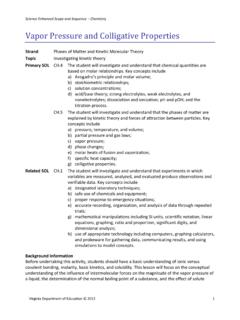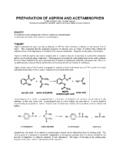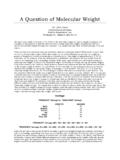Transcription of Colligative Properties of Solutions - hschemsolutions.com
1 Solutions Colligative Properties of Solutions 2010 High School Chem Solutions . All rights reserved. Colligative Properties of Solutions Liquids Solutions experience the following four Colligative Properties : vapor pressure Reduction, Boiling Point Elevation, Freezing Point Depression, and Osmotic pressure , over that of the pure solvent. 2010 High School Chem Solutions . All rights reserved. vapor pressure Top Reduction View Side View Pure Solvent Solvent and Non-Volatile Solute 2010 High School Chem Solutions . All rights reserved. vapor pressure Reduction When a non-volatile solute dissolves in a solvent it becomes evenly distributed throughout the liquid. This means non-volatile particles are on the liquid's surface. Non-volatile particles reduce the surface area from which evaporation is possible. Reduces incidents of evaporation per unit area per unit of time Reduces vapor pressure 2010 High School Chem Solutions . All rights reserved. Raoult's Law: Non-Volatile Solute The partial pressure of a solvent over a solution is equal to the vapor pressure of the pure solvent times the mole fraction of that solvent in the solution.
2 vapor pressure of the pure solvent Psolvent = Xsolvent Posolvent This means that vapor pressure reduction is determined by the concentration, and not the type, of non-volatile particles in the solution. 2010 High School Chem Solutions . All rights reserved. Raoult's Law: Volatile Solute If you have a volatile solute, such as an alcohol, there are two vapor pressures which are additive. Psolvent = Xsolvent Posolvent vapor pressures of Psolute = Xsolute Posolute the pure liquids In the case of a volatile solute, the vapor pressure could go up or down. 2010 High School Chem Solutions . All rights reserved. Raoult's Law: Volatile Solute Psolvent = Xsolvent Posolvent Psolute = Xsolute Posolute Ideal Solutions Ptotal = Psolvent + Psolute Solutions act most ideally when the solute and solvent have similar structures. Intermolecular forces between the solute and solvent molecules are similar to those between solvent molecules. 2010 High School Chem Solutions . All rights reserved.
3 Raoult's Law: Volatile Solute Psolvent = Xsolvent Posolvent Psolute = Xsolute Posolute Non-Ideal Solutions Ptotal < Psolvent + Psolute Occurs when intermolecular forces between solute and solvent molecules are very strong Intermolecular forces between solute and solvent molecules are stronger than those between solvent molecules. 2010 High School Chem Solutions . All rights reserved. Boiling Point Elevation T = 100oC T = 100oC T > 100oC. Pvapor = PH2O = 1 atm PH2O < 1 atm Pvapor = PH2O = 1 atm Pvapor = PH2O. Pure Water Water and Non- Water and Non- Volatile Solute Volatile Solute Boiling Not Boiling Boiling 2010 High School Chem Solutions . All rights reserved. Solutions with Soluble Ionic Compounds Soluble ionic compounds completely dissociate in polar solvents. Colligative Properties depend on the concentration of solute particles in solution. Thus, for strong electrolytes you need to know the concentration of ions, not the concentration of formula units, in the solution.
4 2010 High School Chem Solutions . All rights reserved. Boiling Point Elevation Tb = i mKb Tb = the change in boiling temperature between the solution and the pure solvent. i = van't Hoff factor (Ideally, the number of ions within one formula unit of a strong electrolyte). m = molality (moles solute / kg solvent). Kb = the boiling point constant for the solvent. (Kb for water = K kg/mol). 2010 High School Chem Solutions . All rights reserved. Non-Ideal Solutions and (i). Measured values for (i) are usually lower than the ideal values. This tells us that dissociated ions are not completely independent of one another. Their lack of independence makes the actual number of moles of solute particles slightly less than expected. 2010 High School Chem Solutions . All rights reserved. Looking down at the surface of a non-ideal solution - +. - +. - +. +. - - Ion pairs act like a single particle +. - + - 2010 High School Chem Solutions . All rights reserved. Factors Affecting Non-Ideal Behavior The higher the concentration of solute, the less ideal the behavior.
5 Ions are closer together More ion pairs or clustering The greater the charge on individual ions, the less ideal the behavior. The greater the charge, the greater the tendency for ion to attract one another. Only Solutions with solutes that form ions can behave non-ideally 2010 High School Chem Solutions . All rights reserved. Ex1) Boiling Point Elevation a) What is the boiling point elevation when g of NaCl is added to L of water? b) What is the new boiling temperature of the water at sea level in oC? Step 1. Find molality of solution 2010 High School Chem Solutions . All rights reserved. Ex1) Boiling Point Elevation a) What is the boiling point elevation when g of NaCl is added to L of water? b) What is the new boiling temperature of the water at sea level in oC? Step 1. Find molality of solution 1 mol NaCl g NaCl = mol NaCl g NaCl 2010 High School Chem Solutions . All rights reserved. Ex1) Boiling Point Elevation a) What is the boiling point elevation when g of NaCl is added to L of water?
6 B) What is the new boiling temperature of the water at sea level in oC? Step 1. Find molality of solution 1 mol NaCl g NaCl = mol NaCl g NaCl 1 kg water L water = kg water 1 L water 2010 High School Chem Solutions . All rights reserved. Ex1) Boiling Point Elevation (cont.). Step 2. Find the boiling point elevation. 2010 High School Chem Solutions . All rights reserved. Ex1) Boiling Point Elevation (cont.). moles solute mol NaCl molality = =. kg solvent kg water molality = Step 2. Find the boiling point elevation. Tb = i mK b 2010 High School Chem Solutions . All rights reserved. Ex1) Boiling Point Elevation (cont.). moles solute mol NaCl molality = =. kg solvent kg water molality = Step 2. Find the boiling point elevation. Kb for water Tb = i mK b Tb = ( 2 )( )( K kg / mol ). Tb = K. The new boiling temperature is 2010 High School Chem Solutions . All rights reserved. Ex2) Boiling Point Elevation Ex2) How much NaCl (in grams) must be added to L of water to raise the boiling temperature to oC at 1 atm?
7 Step 1. Find molality 2010 High School Chem Solutions . All rights reserved. Ex2) Boiling Point Elevation Ex2) How much NaCl (in grams) must be added to L of water to raise the boiling temperature to oC at 1 atm? Step 1. Find molality Tb = i mK b Tb m= =. i Kb 2010 High School Chem Solutions . All rights reserved. Ex2) Boiling Point Elevation Ex2) How much NaCl (in grams) must be added to L of water to raise the boiling temperature to oC at 1 atm? Step 1. Find molality Tb = i mK b Tb K. m= =. i K b (2) ( K kg / mol ). m = 2010 High School Chem Solutions . All rights reserved. Ex2) Boiling Point Elevation (cont.). Step 2. Find mass of NaCl 2010 High School Chem Solutions . All rights reserved. Ex2) Boiling Point Elevation (cont.). Step 2. Find mass of NaCl nNaCl m=. kg H 2 O. nNaCl = m(kg H 2 O). nNaCl = ( )( kg). nNaCl = mol NaCl 2010 High School Chem Solutions . All rights reserved. Ex2) Boiling Point Elevation (cont.). Step 2. Find mass of NaCl nNaCl m=. kg H 2 O. nNaCl = m(kg H 2 O).
8 NNaCl = ( )( kg). nNaCl = mol NaCl g NaCl mol NaCl = 37 g NaCl 1 mol NaCl 2010 High School Chem Solutions . All rights reserved. Freezing Point Depression Freezing requires the transition from a disordered to a more ordered arrangement of particles. ( S). Heat must be removed from the system to facilitate this change. ( H). A solution is more disordered than its pure solvent, so freezing a solution requires an even greater decrease in entropy. (more S). Thus, more energy must be removed to freeze a solution. (more H). Occurs in all Solutions Volatile and Non-Volatile Solutes 2010 High School Chem Solutions . All rights reserved. Freezing Point Depression Tf = i mKf Tf = the change in freezing temperature between the solution and the pure solvent. i = van't Hoff factor (ideally, the number of ions within one formula unit of a strong electrolyte). m = molality (moles solute / kg solvent). Kf = the freezing point constant for the solvent. (Kf for water = K kg/mol). 2010 High School Chem Solutions .
9 All rights reserved. Non-Ideal Solutions Like all Colligative Properties , freezing point depression depends on the number of solute particles. Ion pairing and clustering slightly reduces the effective concentration of solute particles. For ionic compounds, freezing point depressions are, in reality, slightly less than would be expected from ideal calculations. Deviations from ideal Solutions increase as the charges of ions and concentrations increase. 2010 High School Chem Solutions . All rights reserved. Ex) Freezing Point Depression Ex) How much ethylene glycol (C2H6O2) must be added to L of water to depress the freezing point to Step 1. Calculate the molality 2010 High School Chem Solutions . All rights reserved. Ex) Freezing Point Depression Ex) How much ethylene glycol (C2H6O2) must be added to L of water to depress the freezing point to Step 1. Calculate the molality Tf = i mK f Tf m= =. i Kf 2010 High School Chem Solutions . All rights reserved. Ex) Freezing Point Depression Ex) How much ethylene glycol (C2H6O2) must be added to L of water to depress the freezing point to Step 1.
10 Calculate the molality Tf = i mK f Tf K. m= =. i K f (1) ( K kg / mol ). m = Kf for water 2010 High School Chem Solutions . All rights reserved. Ex) Freezing Point Depression (cont.). Step 2. Find mass of C2H6O2. 2010 High School Chem Solutions . All rights reserved. Ex) Freezing Point Depression (cont.). Step 2. Find mass of C2H6O2. nC2 H6O2. m=. kg H 2 O. nC2 H6O2 = m(kg H 2 O). nC2 H6O2 = ( )( kg). nC2 H6O2 = mol C2 H 6 O 2. 2010 High School Chem Solutions . All rights reserved. Ex) Freezing Point Depression (cont.). Step 2. Find mass of C2H6O2. nC2 H6O2. m=. kg H 2 O. nC2 H6O2 = m(kg H 2 O). nC2 H6O2 = ( )( kg). nC2 H6O2 = mol C2 H 6 O 2. g C2 H 6 O 2. mol C2 H 6 O 2 = 103 g C2 H 6 O 2. 1 mol C2 H 6 O 2. 2010 High School Chem Solutions . All rights reserved. Osmotic pressure Pure Solution Solvent Semi-Permeable Membrane A filter that only solvent can pass through 2010 High School Chem Solutions . All rights reserved. Osmotic pressure Pure . Solvent Solution Semi-Permeable Membrane A filter that only solvent can pass through 2010 High School Chem Solutions .







